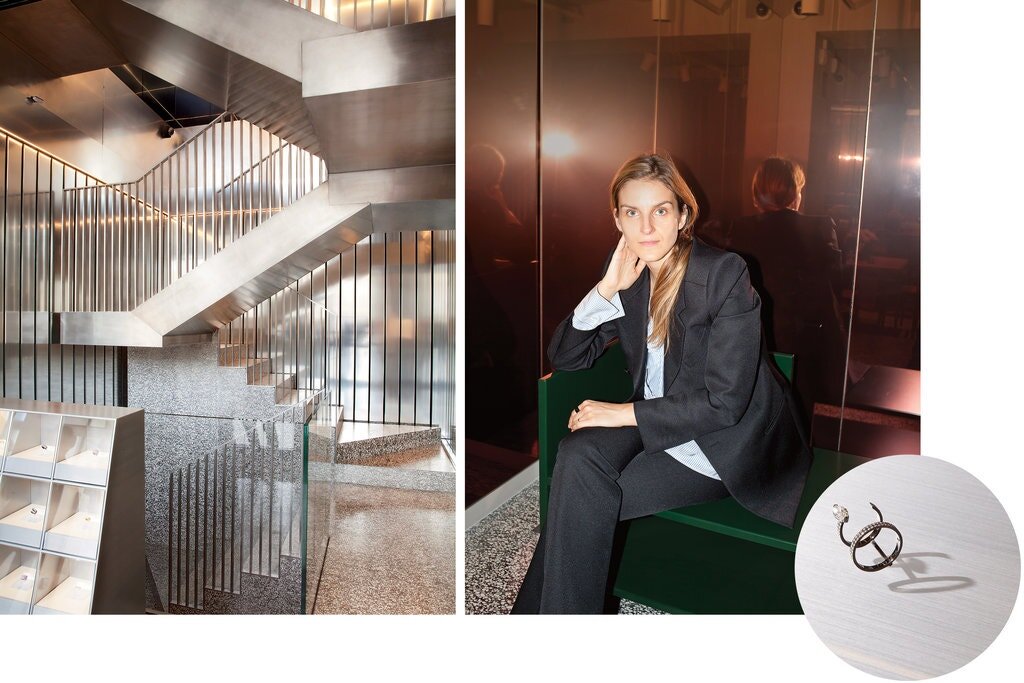T Magazine: The Most Stunning New Store in Paris’s Haute Jewelry Mecca
Photographed by Thibault Montamat
Micro architectures. That is how Gaia Repossi describes the fine jewelry she designs. Not as multi-carat baubles. Or haute fantasias — the provenance of most high-end jewelers. But strict architectural works conceived as human adornment. A series of segmented rings joined by a simple line across the phalanx references the Brutalist lines of Le Corbusier. Delicately looping squiggles suggest, simultaneously, the world of Calder and the spectral images of radio waves.
Even at 30, Repossi is a serious girl. To meet her in London’s Chiltern Firehouse is to bear witness to a study in contrasts. Set against the chintzy, plush surroundings, she cuts a reserved figure. She is dressed in sober, minimalist clothes, and speaks in a barely audible whisper with a slight accent that reflects her upbringing in Monaco, Italy and France. Every now and then, the jewelry that adorns her fingers and ears, climbing up her lobe like tiny stargazers, discreetly catches a glint of light.
Since taking over her family’s business, Maison Repossi, in 2007, Repossi has staked her claim as a quiet revolutionary in the staid world of jewelry, approaching her craft from an analytical point of view, not with the stone as a starting point, but rather “systems and modules that can be combined and repeated with almost infinite possibilities.” She has no formal training and yet, as she says, “It’s just like a tailor growing up in a family of tailors — we know how to see what is a good stone. There can’t be a better school than your own father.” (Her grandfather founded the company in the 1920s.) But where her father cared “about a certain elegance, and how jewelry should enhance and elongate the neck of a woman,” Repossi concerns herself more with “the shape of the object, responding to volume and ideas. The material comes after.” Today, a studio team that includes many who have studied architecture works with 3D printers at the company’s headquarters in Paris, while craftsmen at Repossi’s atelier in Italy use techniques that are nearly a century old. Talk is just as likely to revolve around oxidized metals and hidden settings as negative space and ergonomics.
Repossi’s unconventional approach to jewelry has earned her a growing following among the fashion set and, now, the backing of Louis Vuitton Moët Hennessy, which has taken a minority share in the company. With their support, the business is poised to grow dramatically. “When the opportunity came to invest in Repossi, the decision was taken quite naturally,” says Delphine Arnault, executive vice president of Louis Vuitton and a director of LVMH, who spearheaded the partnership after following the designer closely for years. (This is the first jewelry company LVMH has added to its portfolio.) “We believe in Gaia’s talent.”
So, apparently, does Rem Koolhaas. More than two years ago, Repossi reached out to the architect to redesign the flagship boutique in Paris’s Place Vendôme (also home to Cartier, Van Cleef & Arpels and the quietly tucked away JAR salon, to name a few). She cites Koolhaas’s mammoth 1995 monograph “S,M,L,XL” as inspiration, in its impassioned argument for the importance of the shopping experience in modern society. In collaborating with his firm, OMA, Repossi sought to redefine the concept of the luxury consumer experience: “Rem thinks like an anthropologist, and so I wanted to work with him to try to answer the questions of what is luxury today, and why is it associated with some things and not others.” During their first conversation, Koolhaas insisted that if the product was complex, the display would be simple.
Koolhaas and his OMA team, led by his partner, Ippolito Pestellini Laparelli, spent about a year putting together studies for the store, taking into account Repossi’s personal tastes and interests. They created more than 20 books, on subjects ranging from spatial scenography to kinetics. At one point, Repossi realized she had been presented with 45 proposals just for the store’s staircase.
The three-story boutique, which reopened in July, aims to be a beacon of modernity in the conservative environs of Place Vendôme, creating a tension between Repossi’s meticulously articulated jewelry and the industrial elements OMA has introduced, including concrete, acrylic, aluminum and even a resin made to look like glass. The ground floor acts, according to Pestellini Laparelli, “like an extension of the street,” for speedy sales. (Repossi estimates that the average customer wants to spend up to five minutes on a purchase.) The top floor functions as a gallery, offering the brand’s full range. The basement provides a more intimate space for specialty pieces. The typically static experience of buying jewelry will be challenged with “kinetic displays” that introduce a subtle sense of movement as customers walk through the store, and also with “gradient mirrors” that change reflection when looked at. Koolhaas found the experience of working with jewelry for the first time liberating. “The world today is very conservative,” he sighs over the phone. “It’s simply a challenge to do things that are relatively experimental. There’s an assumption that as things get smaller, they are more remote from ideas. It was interesting to test that possibility of developing and thinking and working with extremely small entities.”
With Donald Judd furniture curated by Repossi, the idea is for the store to feel personal, expressing her interest in pushing the brand forward by merging cutting-edge technology with exquisite materials. “It’s about creating moments that are very modern and sharp and surprising,” she says. “I like the balance between something timeless and something of the instant. Where a woman is surprised but then also identifies herself in it.”
“There’s an assumption that as things get smaller, they are more remote from ideas. It was interesting to test that possibility of thinking, working with extremely small entities.”







